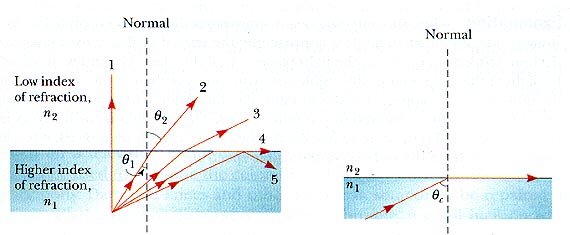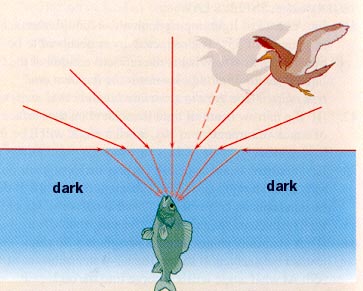
Total Internal Reflection

"One machine can do the work of fifty ordinary
men.
No machine can do the work of one extraordinary man"
Elbert Hubbard

- When light passes from a medium with refractive index n1
to a medium with refractive index n2, where n 1
> n2, if the incident angle is
greater than some critical angle
 , the light will
undergo total internal reflection (TIR).
, the light will
undergo total internal reflection (TIR).
- The diagram below represents a light source underwater with light
rays striking the water-air interface. Rays 1, 2 and 3 are
refracted at the interface according to Snell's law, the refracted ray
bending away from the normal such that
 >
>  . When
. When  = 90o the refracted ray
is directed along the surface of the water and
= 90o the refracted ray
is directed along the surface of the water and  is
called the critical angle
is
called the critical angle  . For incident
angles greater than
. For incident
angles greater than  there is no
refracted ray, the
light undergoes total internal reflection back into
the water.
there is no
refracted ray, the
light undergoes total internal reflection back into
the water.
- At the critical angle
For light passing into air from water the critical angle is equal
to about 49o.
- Thus a fish-eye's view is of the world in a 98o cone.
Outside this cone all is darkness...[Actually this is not true
due to the scattering of light in water]
- Total Internal Reflection is the mechanism by which fibre optic
cables work. Signal losses along such cables is extremely small
since ALL the incident energy is reflected.

 "I
know that this defies the
law of gravity, but, you see, I never studied law."
"I
know that this defies the
law of gravity, but, you see, I never studied law."
Bugs Bunny

Dr. C. L. Davis
Physics Department
University of Louisville
email: c.l.davis@louisville.edu


 , the light will
undergo total internal reflection (TIR).
, the light will
undergo total internal reflection (TIR). >
>  . When
. When  = 90o the refracted ray
is directed along the surface of the water and
= 90o the refracted ray
is directed along the surface of the water and  is
called the critical angle
is
called the critical angle  . For incident
angles greater than
. For incident
angles greater than  there is no
refracted ray, the
light undergoes total internal reflection back into
the water.
there is no
refracted ray, the
light undergoes total internal reflection back into
the water.



 Supplementary Problems
Supplementary Problems
